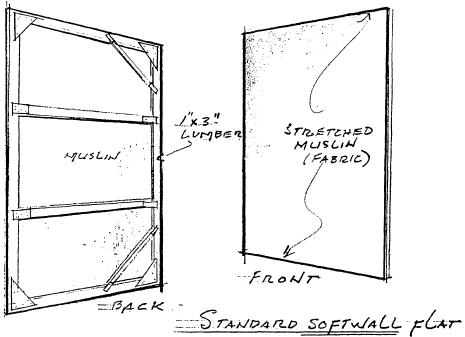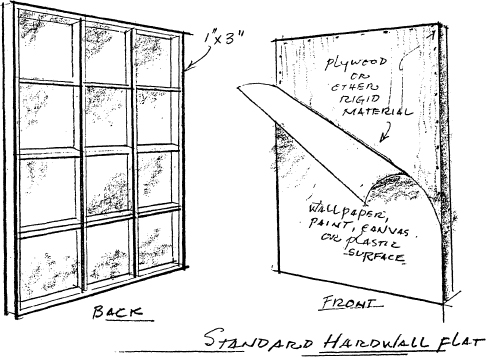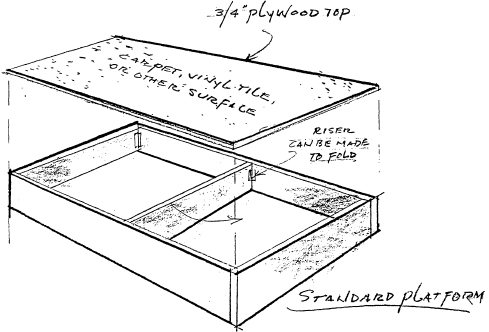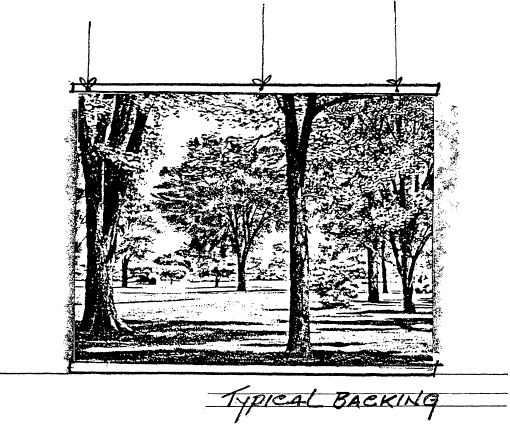As we saw earlier, pioneering movie producers relied heavily on theatrical tradition, adapting plays and staging techniques to the new film medium. Film and video set designers built on traditional methods as well, adding more sophisticated materials and techniques as they became available.
Softwall Flats
In the traditional theater, where lightweight, easily transportable scenery is an asset, the basic flat, or wall surface, is a wood framework covered with stretched, painted fabric. This method of construction evolved through centuries of use and is ideal for theatrical purposes. Under a theatrical stage’s controlled conditions where the audience is a distance away from the scenery, painting and construction can be bold and lack detail.
Early television production followed traditional construction and painting techniques in the same way that motion pictures did. Early technical equipment allowed little transmitted detail, so stage techniques served the purpose. Contemporary stage, video, and film setting construction, however, uses metal and new synthetic materials as the character of production changes and technical skill improves. The traditional softwall flat lives on in motion picture and video for ceilings and painted backings, where rigidity and durability don’t count.
Hardwall Flats
Durable hardwall flats can be used over and over with many surface changes. Carpenters can remove the existing skin and replace it or cover it with new plywood, masonite, composition board, or vacuum-formed plastic sheeting. Hardwalls also provide sturdy surfaces for fastening light fixtures, picture hooks, and shelving.



Basic hardwall flats are made of a framework of 1" x 3" wood set on edge. Lumber sizes are named by the measurements of the rough wood before it is planed down to smooth surfaces. The 1" x 3" dimensions become ¾" x 2½" after the wood is finished. The so-called 1 x 3 is set on edge and made into a grid, each square measuring 24” x 24” on the centers of the lumber thickness. A skin, or covering of plywood or composition board, is nailed and glued to one side of the framework. Standard widths range from 12 inches to 8 feet and heights range from 6 feet to 14 feet.
Designers use platforms to create floor level changes. Platforms traditionally are made of wood, but they can be metal framed for extra durability and covered with appropriate materials such as plywood, carpet, and vinyl sheeting.
Plywood sheets form platform tops, which are usually set on folding frames called parallels, hinged at the corners to fold for storage. Standard sizes begin at 4′ x 4′ and go up to 4′ x 10′. Parallel base heights commonly begin at 6" and go up in 6 inch progressions to 4′. Standard sizes, based on 4′ x 8′ material sheets, provide flexibility and cost-effective advantages. Practical designers combine standard sizes to form raised areas. Nonstandard platform construction escalates set costs, but cannot be avoided in many designs.

Today’s designers have a constantly changing palette of materials, compared to earlier times when paint, canvas, and wood were the limit. Vacuum-formed plastic sheets can reproduce nearly any form or texture, and look convincing when applied to flats and expertly painted. Vacuum-form shops publish catalogs of sheets depicting commonly used surfaces such as brick, shingles, and wood planking.
Vinyl materials can give a dazzling look to sets. Many designers design with light to bring out the reflective qualities of new materials, and appreciate the lightweight plastic sheet compared to the former plaster-and-excelsior method of presenting brick and stone.
Designers use large painted muslin cloth areas to present scenery that does not need to be built. Commonly called backdrops, backings can be huge, covering the walls of entire soundstages, or small enough to cover open doors or windows.

Scenic artists paint backings from designs presented by the art director or production designer. Backings can be 30 feet high and hundreds of feet long, so scenic studios have paint frames on which they fasten cloth material that can be raised and lowered for the artists standing on scaffolds or the shop floor, if it has a well into which the material can be lowered.
Backings that hang in a straight, horizontal line roll up on wood battens fastened to the top and bottom. Large soundstage backings, which curve around the walls, are usually painted in place by artists working with spray painting equipment.
The Difference Between Day and Night
Some backings depict both day and night and are lit from the back or from the front. In the case of a painted city scene, for example, the daytime appearance is seen by reflected light off opaque painting on the cloth material. For the night effect, the building windows, signs, and a portion of the sky are painted with translucent dyes or paint; when lit from behind, they give a nighttime look.
Some backings are giant strips of photographic positive film. Translucent film stock lends itself to night scenes and is lit from behind, giving a particularly realistic depiction of night lighting. Backing rental houses offer a wide variety of choices.
Early movie makers had to rely on backings, built like giant roller towels on their sides, to depict moving scenery behind a prop horse, automobile, or train. As techniques improved, they projected motion picture film on a translucent screen to give the illusion of traveling or moving.
•
Not all scenery is made of wood, canvas, and paint Some settings exist only in digital form, as you will see in the next chapter.
